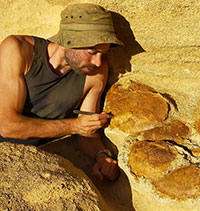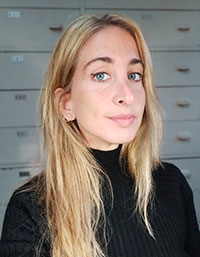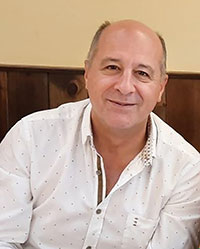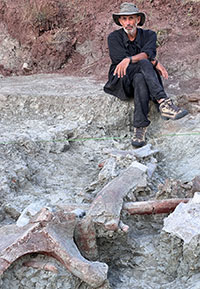 Adán Pérez-García. Grupo de Biología Evolutiva, Dpto. de Física Matemática y de Fluidos, Facultad de Ciencias, UNED, Avda. Esparta s/n, 28232, Las Rozas, Madrid, Spain. (Corresponding author) a.perez.garcia@ccia.uned.es
Adán Pérez-García. Grupo de Biología Evolutiva, Dpto. de Física Matemática y de Fluidos, Facultad de Ciencias, UNED, Avda. Esparta s/n, 28232, Las Rozas, Madrid, Spain. (Corresponding author) a.perez.garcia@ccia.uned.es
Adán Pérez-García is a researcher at the Evolutionary Biology Group of the National University of Distance Education (UNED, Madrid, Spain), and a Senior Lecturer at the Faculty of Sciences of that University. His main field of research corresponds to the study of the evolutionary history of the turtles, both European forms and taxa related to them that inhabited other continents, especially Africa. He focused on the study of several Mesozoic turtle lineages during the development of his PhD Thesis (presented in 2012), currently working in the study of the systematics, paleobiogeography and diversity of both Mesozoic and Cenozoic forms. He has directed several national and international research projects that involved the analysis of reptile faunas, especially from the Mesozoic. He is the author of more than 150 scientific papers in SCI journals, and about 300 contributions presented in specialized scientific conferences. He has described more than 35 new genera and more than 35 new species of reptiles, most of them turtles, but also crocodiles and sauropterygians.
![]()
 Andrea Guerrero. Grupo de Biología Evolutiva, Dpto. de Física Matemática y de Fluidos, Facultad de Ciencias, UNED, Avda. Esparta s/n, 28232, Las Rozas, Madrid, Spain. guerbach@gmail.com
Andrea Guerrero. Grupo de Biología Evolutiva, Dpto. de Física Matemática y de Fluidos, Facultad de Ciencias, UNED, Avda. Esparta s/n, 28232, Las Rozas, Madrid, Spain. guerbach@gmail.com
Dr. Andrea Guerrero is a paleontologist specializing in fossil turtles. She recently completed her PhD in 2024 under the supervision of Dr. Adán Pérez García and Dr. Francisco Ortega at the Universidad Nacional de Educación a Distancia in Madrid, Spain. Her research focuses on the morphological variability of various European turtle groups, employing both qualitative and quantitative frameworks. Additionally, she is interested in turtle paleopathologies, three-dimensional reconstruction of muscles and bones, and biomechanics.
![]()
 Santiago Martín de Jesús. Colección de Vertebrados Fósiles de la Cuenca del Duero (Sala de las Tortugas), Departamento de Geología, Facultad de Ciencias, Universidad de Salamanca, Salamanca, Spain. saladelastortugas@usal.es
Santiago Martín de Jesús. Colección de Vertebrados Fósiles de la Cuenca del Duero (Sala de las Tortugas), Departamento de Geología, Facultad de Ciencias, Universidad de Salamanca, Salamanca, Spain. saladelastortugas@usal.es
Graduate in Geology from the University of Salamanca (1981-1986). Thesis: "The fossil Crocodylia of the Duero Basin" (1986). Master in Computer Science at the Pontifical University of Salamanca (1988-1990). After four years as a research fellow at the USAL on fossil reptiles of Spain, he spent most of his working life in the fields of graphic design, web design and programming, along with teaching. Since 2014 he has been the Scientific Curator of the Collection of Fossil Vertebrates of the Duero River Basin "Sala de las Tortugas" of the USAL and in 2019 he is directing the Project for the remodelling of the space of this collection. He has developed the digitisation and inventory of the collection, a process that has been key to all the research carried out in recent years.
![]()
 Francisco Ortega. Grupo de Biología Evolutiva, Dpto. de Física Matemática y de Fluidos, Facultad de Ciencias, UNED, Avda. Esparta s/n, 28232, Las Rozas, Madrid, Spain. fortega@ccia.uned.es
Francisco Ortega. Grupo de Biología Evolutiva, Dpto. de Física Matemática y de Fluidos, Facultad de Ciencias, UNED, Avda. Esparta s/n, 28232, Las Rozas, Madrid, Spain. fortega@ccia.uned.es
Francisco Ortega is a PhD in Biology (Paleontology) and a Professor at the Faculty of Sciences of UNED (Madrid), where he teaches subjects related to biodiversity to Environmental Sciences students. He is also the Principal Investigator of the Evolutionary Biology Research Group-UNED, focusing on analyzing the evolutionary history of Mesozoic reptiles, particularly crocodiles and dinosaurs, and their ecosystems.
He has authored more than one hundred publications in scientific and technical journals, primarily focusing on the Upper Jurassic of Portugal, both in the Lower and Upper Cretaceous of Spain, and in the Paleogene of Spain. Additionally, he has played a role in developing museum and museographic projects in Spain and Portugal.
His involvement extends to various paleontological research projects in Spain, Portugal, Niger, Argentina, and the United States, which implies being part of almost one hundred excavations and over twenty national and international research projects.

